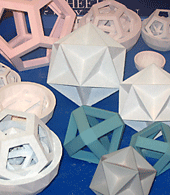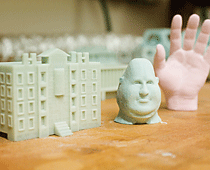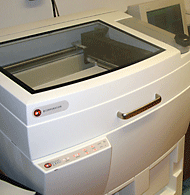This Machine
Lifts Printing Off the Page
Just a few
of the items produced by the Zprinter 310
|
Until recently, printing images from the computer has been
a limited process, stuck in a single dimension, in which
a picture is stenciled with ink onto a flat sheet of paper.
But with the introduction during the past decade of machines
designed to recreate images (i.e. shapes) in three dimensions,
the future of printing has lifted off the page and become
unlimited.
Smith College has stepped
into that future with its own 3-D printer—a Zprinter 310, officially, made by Z-Corp,
an international hi-tech equipment manufacturer—that
takes a scan of a three-dimensional image and automatically
casts it in physical form.
Three-dimensional printers, also known as rapid prototypers,
have been introduced to the market with wide-ranging applications.
Such machines are already being used to make candy in any
imaginable shape, and jewelry of wildly intricate design.
Behrokh Khoshnevis, an engineer at the University of Southern
California, has invented a prototyper that is soon expected
to print out an entire 2,000-square-foot house in a single
day.
And while one company called Desktop Factory soon plans
to introduce a 3-D printer, available for under $5,000, that
can recreate plastic models, it may be a while before three-dimensional
printers become a staple of every home, as some predict.
 Smith’s 3-D printer,
a $30,000 machine, was purchased two years ago with a combination
of funds from the Picker Engineering Program and a $93,000
grant from the National Science Foundation. Those funds
also supported the purchase of a laser scanning device
and a laser cutting machine. Smith’s 3-D printer,
a $30,000 machine, was purchased two years ago with a combination
of funds from the Picker Engineering Program and a $93,000
grant from the National Science Foundation. Those funds
also supported the purchase of a laser scanning device
and a laser cutting machine.
Joseph O’Rourke, the Spencer T. and Ann W. Olin Professor
of Computer Science and chair of that department, procured
the grant and has since become the campus expert on 3-D printing.
O’Rourke sees great potential for the technology used
by the college’s printer.
“I knew that this type of machine was useful for engineering,
and obviously for architecture,” said O’Rourke, “but
I see a lot of possibilities for art. I wanted to connect
art, science, engineering, mathematics. There are unlimited
possibilities. I think it hasn’t been fully absorbed
what the possibilities are.”
So far, O’Rourke has used
the Zprinter in teaching his course on computer graphics,
as well as to create solid objects of various shape and utility.
His students have used the machine to print out intricate
mini-replicas of several campus buildings designed
on the computer. O’Rourke has even programmed the CT
scan of a man’s
skull (by request of a medical researcher) and printed out
a replica.
“You can do things with this machine that you couldn’t
do before,” said O’Rourke. “You could never
do this by hand.”
All three-dimensional printers use a similar process of
reading a scanned image and then physically recreating that
image by emitting a series of layers of non-solid material,
which are solidified during the printing process. A candy
printer, for example, builds scanned layers of sugar, then
heats the sugar to make a solid. The Desktop Factory machine
builds an image with liquefied plastic that quickly cools
in the shape of the scanned image.
 Smith’s printer
releases layers of a specially made powder followed closely
by a binding agent that coalesces the powder into a hard
chalky form. That form can then be painted or dipped in
a coating material, or a mold can be made from the form
using any material desired. It takes about four hours to
complete the printing process. Smith’s printer
releases layers of a specially made powder followed closely
by a binding agent that coalesces the powder into a hard
chalky form. That form can then be painted or dipped in
a coating material, or a mold can be made from the form
using any material desired. It takes about four hours to
complete the printing process.
“This machine is very intelligent,” says O’Rourke. “But
it’s not easy to run. There’s a real art to using it. I’m
still learning how to use the thing.”
O’Rourke is interested
in exploring the many uses of the 3-D printer, he says, and
invites students and faculty from the Five Colleges to investigate
its possibilities.
"There's a lot of interest in
linking art and technology at this college," he said. "I
think it's a great avenue. I
want to have art-oriented students as well as science students.”
|























